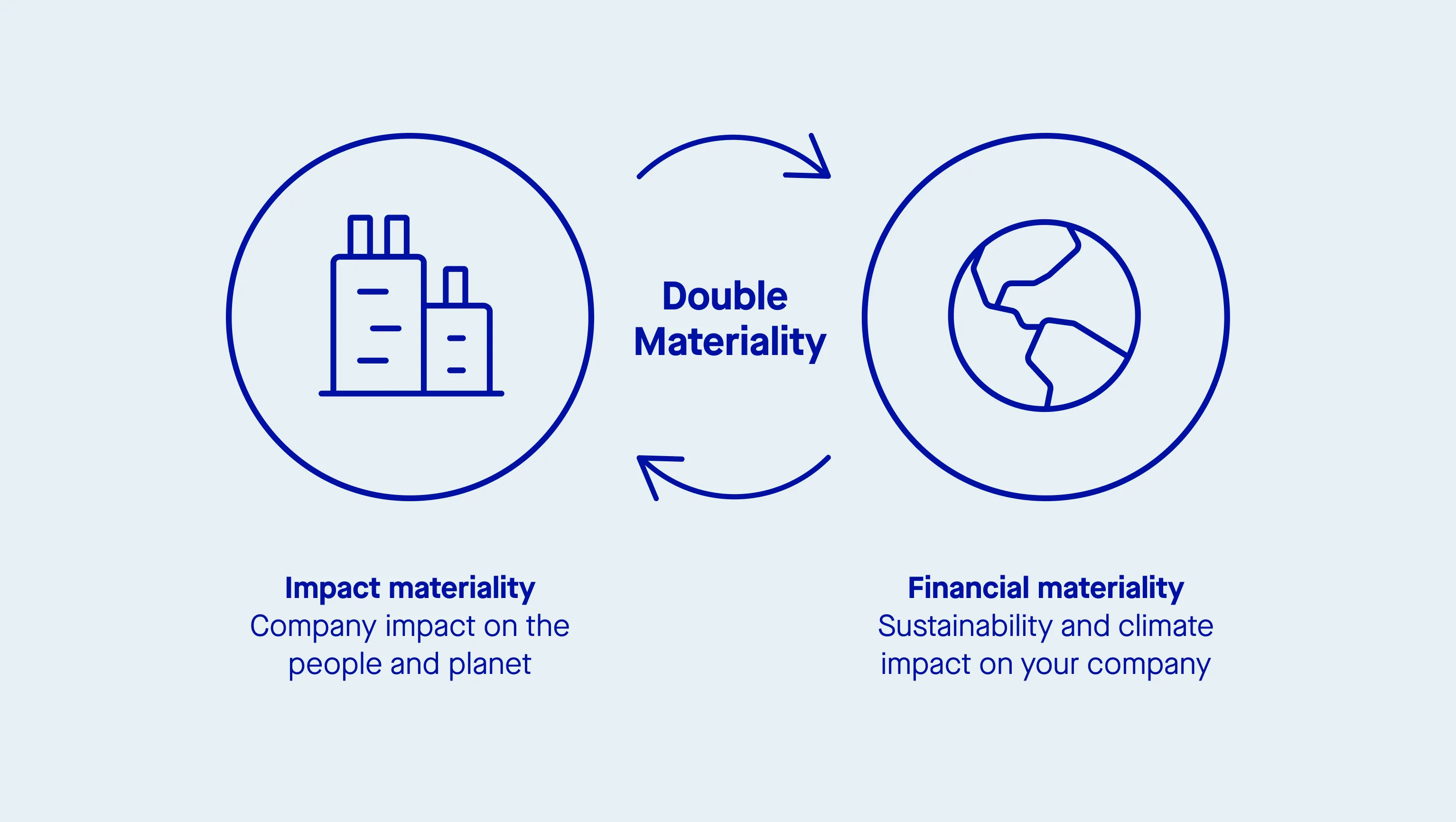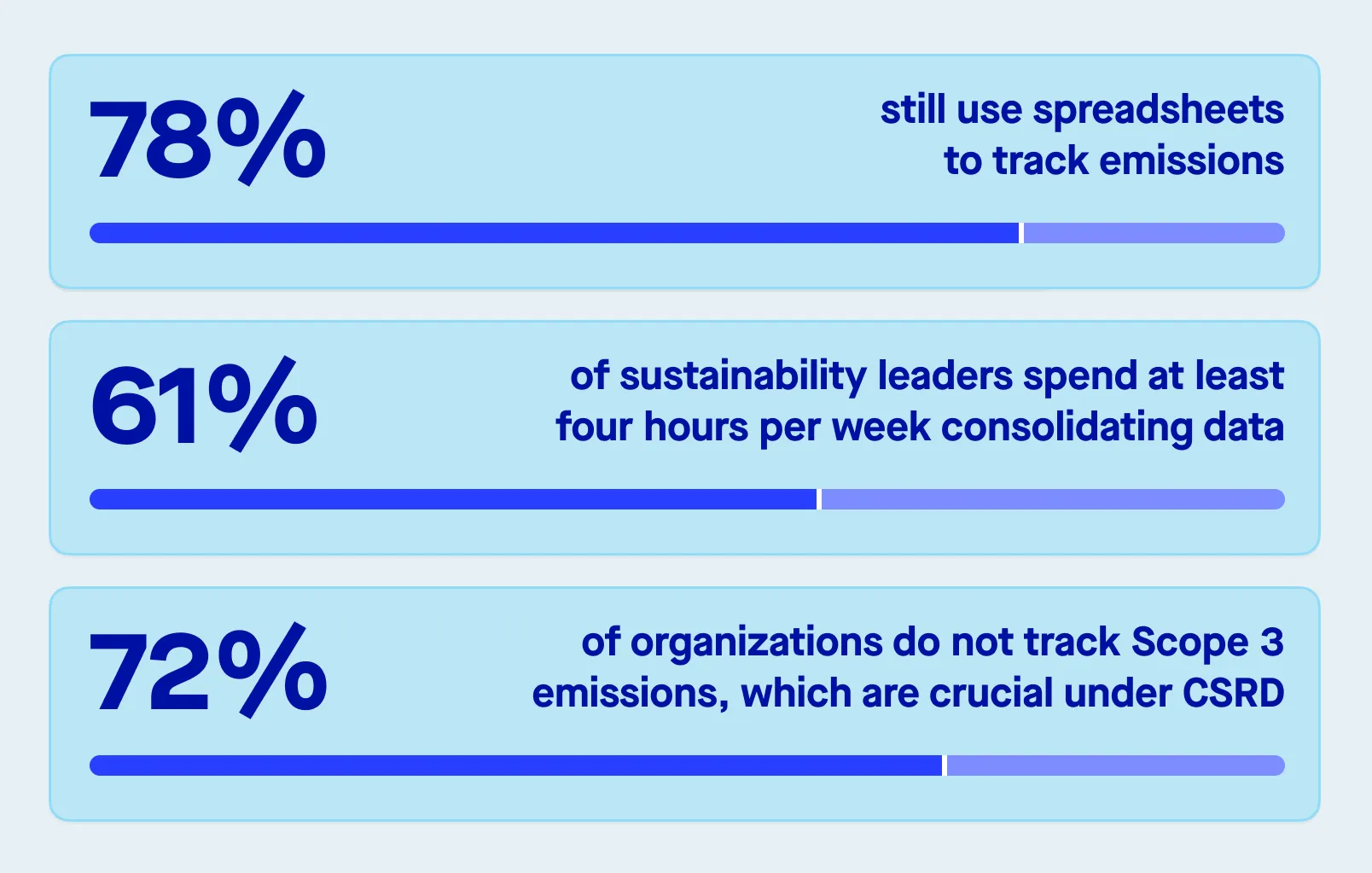15 key areas to focus on when choosing CSRD software
We’ve outlined the key areas to focus on when selecting a CSRD software provider, along with specific questions you can include in your Request for Proposal (RFP) to ensure the solution meets your needs. Utilizing CSRD reporting software can significantly enhance the efficiency and accuracy of your sustainability reporting processes.
1. Compliance and reporting standards
Why it matters:
As regulations evolve, your software must stay up-to-date with the latest CSRD requirements and ESRS guidance to avoid compliance risks. A future-proof solution ensures your reports meet regulatory standards, positioning your business as a sustainability leader. The ability to align with other frameworks also streamlines reporting, allowing you to avoid duplicating effort.
2. Data collection and governance
- Does the software provide automatic data gap analysis based on your materiality assessment?
- Can it handle various data input methods (e.g., manual uploads, APIs, surveys)?
- Does the software have collaborative tooling to track data collection campaigns?
- Does it streamline data collection from multiple IT systems and external sources?
- Does it ensure consistency checks for maintaining financial-grade data quality?
Why it matters:
Efficient data collection is essential for accurate CSRD reporting. Automating data gap analysis ensures you can identify missing information early, reducing the risk of incomplete reports. A robust data governance structure ensures your ESG data is as reliable and verifiable as your financial data, which is crucial for stakeholder trust and audit readiness.
3. Integration capabilities
- Can the software integrate with existing systems like ERP, HR, or financial platforms?
- Does it support seamless data transformation and quality checks during the integration process?
- Is there flexibility for future system integrations as your technology stack evolves?
Why it matters:
Integrating with your current systems creates a unified ecosystem, ensuring that sustainability data flows seamlessly between platforms. This integration helps avoid data silos and manual data entry errors, improving overall productivity and enabling a comprehensive view of your sustainability performance across business functions.
4. Scalability and flexibility
- Can the software scale to manage increasing volumes of data and growing regulatory complexity?
- Is it adaptable to complex organizations with multiple subsidiaries, business units, or regions?
- Does it allow customization to fit your unique processes and reporting requirements?
Why it matters:
As your company grows, so will your data and reporting needs. Scalable software ensures that your platform can handle increased data loads and complex reporting structures. Flexibility is key to adapting to industry-specific requirements or changes in your organizational structure without needing to invest in new tools.
5. User-friendliness and workflow management
- Does the software have an intuitive interface that promotes easy user adoption?
- Does it offer configurable workflows across different functions (e.g., sustainability, finance, IT)?
- Does it provide tools for data validation and quality checks during the workflow?
Why it matters:
CSRD reporting involves input from multiple departments, and a user-friendly platform encourages collaboration. Configurable workflows ensure that tasks are assigned efficiently and completed accurately. Data validation features help ensure the accuracy of information before it is reported, reducing the risk of errors.
6. Reporting and analytics
- Can the software generate reports compliant with CSRD requirements?
- Does it support exporting reports in formats like Excel or Word for further review?
- Does it provide customizable dashboards for real-time data visualization?
- Can it benchmark your performance against industry standards or peers?
- Can it provide multidimensional reporting with analytics across regions, business units, product type, brands, etc.?
Why it matters:
Real-time analytics and data visualization allow you to monitor your sustainability performance throughout the reporting period. The ability to benchmark against industry standards helps you stay competitive and identify areas for improvement. Additionally, customizable reports ensure that you can tailor information for different stakeholders, from executives to investors.
7. Double materiality assessments
- Does the software provide tools for conducting both financial and impact materiality assessments?
- Can it categorize and prioritize ESG issues based on severity and relevance?
- Does it offer visuals for tracking and analyzing risks, impacts, and opportunities?
Why it matters:
Double materiality is central to CSRD, requiring you to assess both financial risks and the broader environmental and societal impacts of your operations. The right software will help you assess and prioritize key issues, giving you a comprehensive view of your material impacts and helping you make informed decisions that align with your strategic goals.

8. Security
- What level of data security does the software offer?
- Is the software SOC2 certified and ISO 27001 compliant?
- What are the software’s disaster recovery and business continuity plans?
- Is the software hosted in Europe and is it GDPR-compliant?
Why it matters:
ESG data management involves collecting, storing, and processing sensitive data such as energy usage, emissions data, and financial information. This data must be kept confidential and secure to protect your intellectual property and prevent unauthorized access or breaches.
If your prospective provider is SOC 2 or ISO 27001 certified it’s a good indication that they take data privacy and security seriously. Both of these are internationally recognized standards that provide frameworks for information security management.
Depending on your jurisdiction, it’s also worth asking about the provider’s compliance with data regulations such as GDPR.
9. Support and training
- Does the vendor offer comprehensive onboarding and training programs?
- Are there ongoing e-learning modules and live technical support available?
- Does the software release regular updates with new features and improvements?
- Is a dedicated customer success team provided for long-term support?
Why it matters:
Strong support and continuous training are vital for maximizing the value of your CSRD software. A dedicated customer success team can help you stay ahead of new reporting requirements and ensure your staff are equipped to use the platform effectively, driving successful implementation and long-term results.
10. Cost of software and services
- Is the pricing structure transparent, covering licensing, implementation, and support?
- Does the software offer clear cost savings through automation and efficiency gains?
- Can the platform scale affordably as your business and reporting needs grow?
Why it matters:
CSRD software should provide long-term value, not just in compliance but also in efficiency. Transparent pricing ensures you understand the full cost of ownership, and potential cost savings from automation and efficiency gains can provide a strong return on investment over time.
11. Vendor expertise and reputation
- Does the vendor have experience working with companies in your industry and of similar size?
- Does the vendor have a proven track record in CSRD and sustainability reporting?
- Is there a commitment to ongoing product innovation and staying ahead of regulatory changes?
- Does the vendor have a strong network of partners with CSRD expertise?
Why it matters:
Choosing a vendor with relevant expertise ensures you have a trusted partner who understands the complexities of your industry and can offer tailored support. A strong reputation for innovation means the platform will evolve alongside regulatory requirements, keeping your reporting process up-to-date.
12. Stakeholder engagement
- Does the software facilitate engagement with internal and external stakeholders?
- Can it support tools for surveys and benchmarking to gather stakeholder feedback?
- Does it provide transparency on the roles and responsibilities of each stakeholder?
- Does it have a structured validation workflow to streamline the data governance?
Why it matters:
Engaging with stakeholders—whether employees, investors, or customers—is critical for sustainability initiatives. The right software helps foster a culture of sustainability by encouraging transparency and collaboration across your organization and value chain.
13. Audit readiness
- Does the software provide a dedicated user profile for audit assurance?
- Can it provide access to detailed audit trails and document proofs?
- Does it record all changes in line with external audit requirements?
Why it matters:
Preparing for audits can be time-consuming, but audit-ready software simplifies the process by maintaining detailed records and providing transparent audit trails. This helps reduce the administrative burden and ensures compliance with both internal and external audit requirements.
14. Carbon accounting and transition planning
- Does the software support advanced carbon tracking across Scope 1, 2, and 3 emissions?
- Does it have supplier engagement capabilities to calculate supply chain emissions?
- Can it connect with ERP systems to automate procurement data collection?
- Does it allow for target setting with a multi-year approach?
- Can it run scenario analyses and manage decarbonization initiatives?
- Does it offer near real-time performance tracking?
- Does it support transition planning beyond carbon (e.g. waste, water and social)
Why it matters:
With ESRS E1 focusing heavily on climate-related disclosures, having robust carbon management capabilities is essential. Accurate tracking and scenario analysis help you set realistic decarbonization targets and monitor progress toward net-zero goals, ensuring alignment with your sustainability strategy. And having the ability to drive performance across all ESG metrics is crucial.
15. Implementation and change management
- Does the vendor provide a clear implementation roadmap?
- Is a sandbox environment available for testing and training?
- Does the vendor offer change management support to facilitate company-wide adoption?
Why it matters:
Successful implementation requires careful planning and support. A clear roadmap and change management resources help ensure the platform is adopted effectively across your organization, driving efficiency and maximizing the value of your investment.
Choose smarter for CSRD compliance success
Selecting the right CSRD software is essential for meeting regulatory requirements, improving data accuracy, and driving your sustainability goals. By focusing on key areas like compliance, data integration, scalability, and user experience, you can ensure that your chosen solution not only simplifies reporting but also enhances your overall sustainability strategy. Remember, the right software is an investment in both compliance and long-term business value.






